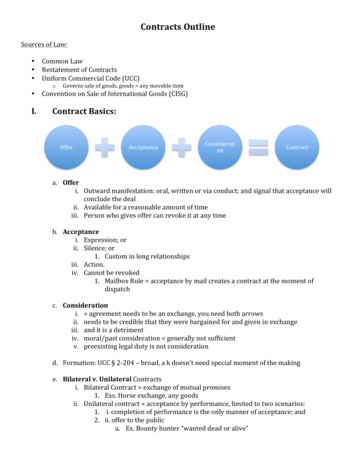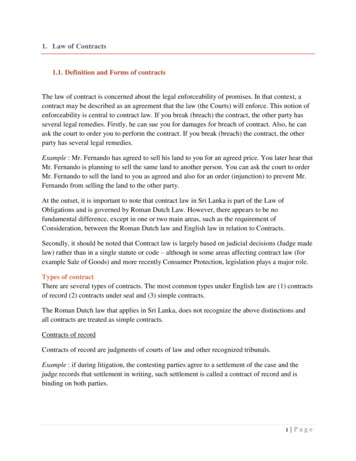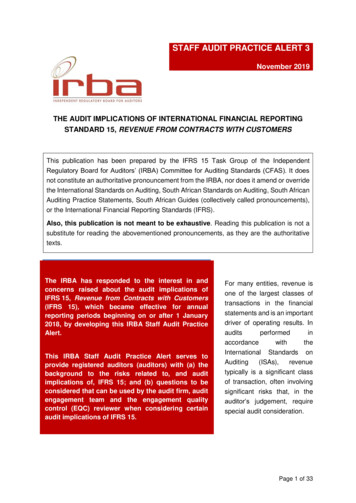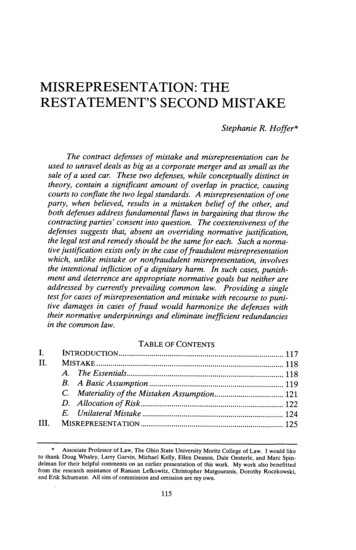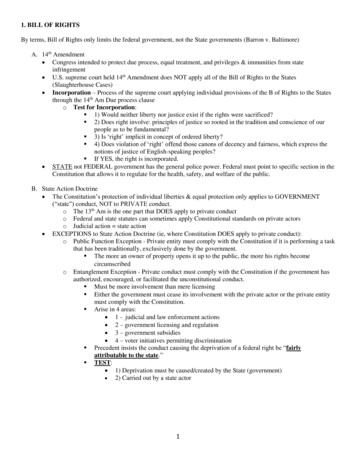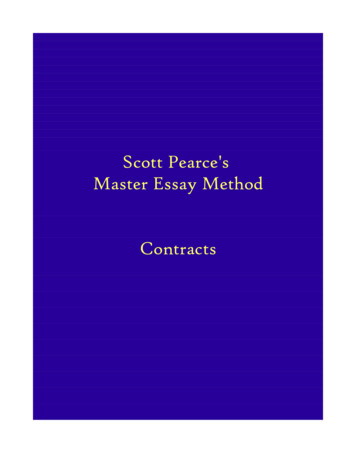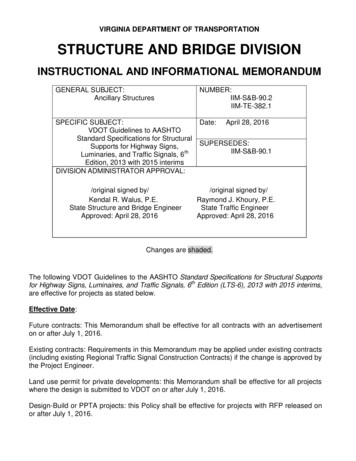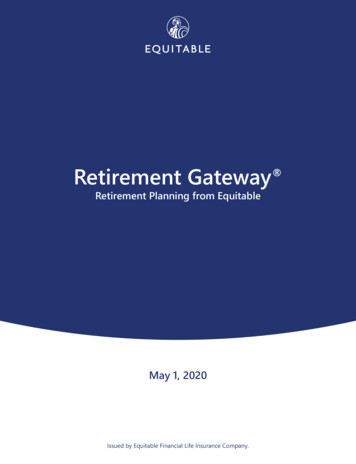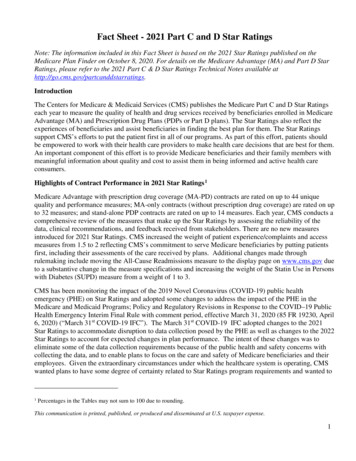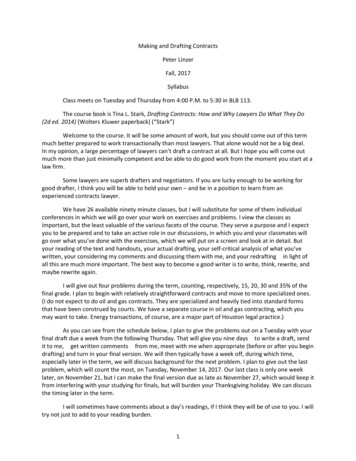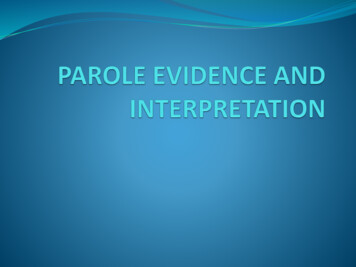
Transcription
Restatement (Second) of Contracts §213. EFFECT OF INTEGRATED AGREEMENT ON PRIOR AGREEMENTS(PAROL EVIDENCE RULE) (1) A binding integrated agreement discharges prior agreements tothe extent that it is inconsistent with them. (2) A binding completely integrated agreement discharges prioragreements to the extent that they are within its scope. Comments: a. Parol evidence rule. This Section states what is commonly knownas the parol evidence rule. It renders inoperative prior writtenagreements as well as prior oral agreements. Where writings relatingto the same subject matter are assented to as parts of onetransaction, both form part of the integrated agreement.
§215. Contradiction of Integrated Terms Except as stated in the preceding Section, wherethere is a binding agreement, either completely orpartially integrated, evidence of prior orcontemporaneous agreements or negotiations isnot admissible in evidence to contradict a term ofthe writing. “It will become obvious that intricate webs ofrules have been constructed by Various minds.There is no unanimity as to the content of theparol evidence rule or the process of itsinterpretation. The rules re complex, technical,and difficult to apply.”Joseph M. Perillo, Calamari & Perillo on Contracts, 6thEdition, pg. 196
Introduction to the Parol Evidence Rule Basic Rule - Final agreement supersedes tentativeterms discussed in earlier negotiations. Parol Evidence Rule only comes into play whenthere is a written and binding contract. Completely Integrated Contract - No ParolEvidence Partially Integrated Contract - No Parol Evidenceas to Integrated Aspects of Contract
Prior, Contemporaneous, andSubsequent Agreements Prior Agreements - Barred Contemporaneous Agreements - Disputed Williston/Restatement First –Oral Prior AgreementsWritten Part of Integration and Admissible Corbin - There is no “Contemporaneous” Majority - Williston Rule The Roles of Judge and Jury - Integration, though seeminglya question of fact, is treated as a question of law.
Is the Writing Integrated? Finality Is there a written document and do the Partiesintend the document to be a FINAL embodimentof their agreement? Any relevant evidence may be introduced to showthe document was not intended to be final. Is the Writing a Total Integration? Completeness Total vs. Partial Integration - While intended as afinal embodiment of an agreement, how much ofthe agreement does it embody?
Tests Used to Determine Completeness: The "Four Corners" Rule - If it looks like a duck. Ifthe agreement appears to be complete, it will betreated as complete. - View is on the decline, butstill used frequently The "Collateral Contract" Concept - Independentagreements maybe introduced so long as they donot contradict the integrated writing
Tests Used to Determine Completeness: Williston's Rules - Presence of a merger clause creates arebuttable assumption that the agreement is fully integrated. Rebutted if a) The document is obviously incomplete or b) mergerwas included by mistake. If no merger clause, look to the writing. If it would appear to areasonable person to be complete, it is deemed a totalintegration Corbin's Approach - Set out above, substitutes intent ofparties for reasonable person test.
Tests Used to Determine Completeness: The UCC Rule § 2-202. Final Written Expression: Parol or Extrinsic Evidence. Terms with respect to which the confirmatory memoranda of theparties agree or which are otherwise set forth in a writing intendedby the parties as a final expression of their agreement with respect tosuch terms as are included therein may not be contradicted byevidence of any prior agreement or of a contemporaneous oralagreement but may be explained or supplemented (a) by course of dealing or usage of trade (Section 1-205) or bycourse of performance (Section 2-208); and (b) by evidence of consistent additional terms unless the court findsthe writing to have been intended also as a complete and exclusivestatement of the terms of the agreement.
Is the Offered Term Consistent orContradictory? Actual contradiction (differing terms) vs. inferred contradiction(absence of an obligation when other obligations are listed) Contradiction of unstated but implied terms (i.e., delivery) - no clearrule Merger Clauses - a provision in a contract that declares it to be thecomplete and final agreement between the parties. Such a provisionin a contract is treated as proof that no varied or additionalconditions exist with respect to the performance of the contractexcept those that are in the writing. It may also be called anintegration use/ Most courts - definitive absent mistake or fraud or document isobviously incomplete Minority rule - just one factor to look at
Inapplicability of Parol Evidence Rule toNon-Contractual Writings Parol Evidence may be used to show that no contract wasformed, is void, voidable, was signed under duress, becauseof fraud, or any other issue that would lead to adetermination that no contract formed or, if formed, wasmodified, terminated or terminable No contract No Integration Parol Evidence may be introduced to prove any of the following: 1.2.3.4.5.6.7.That the writing was not intended to be a contractThat the contract was subject to an express conditionFraudMistakeIllegality and UnconscionabilityAbsence of considerationIdentity of Parties
Application of the Rule to Third Persons Related 3rd parties (3rd Party Beneficiaries) -The rule applies Unrelated 3rd Parties - No reason to applyrule
Contract Interpretation Interpretation as distinct from the parole evidence rule: Parol Evidence Rule relates to the identification of the termsincorporated into the agreement. Interpretation relates to the meaning of the terms incorporatedinto the agreement The Plain Meaning Rule vs. Ambiguity The Plain Meaning Rule is the interpretive equivalent of the ParoleEvidence Rule. It states that if the writing, or a term, is plain andunambiguous on its face, then its meaning must be determinedfrom the four corners of the document. Some jurisdictions allow outside evidence to show that the term orwriting is, in fact, ambiguous. Majority of jurisdictions use the rule, although it has been widelycriticized for lacking context.
Williston vs. Corbin Williston: The written agreement has a unique and powerful forceof influence. To the extent that the written agreement is clear inmeaning to a reasonable person, that written agreement is thesuperseding force that dictates the terms of the contract (to theexclusion of parol evidence to the contrary). FOCUS: The integration practices of reasonable personsacting normally and naturally. Corbin: The written agreement only contains the unique andpowerful force when the parties intend the agreement to havesuch a force at the time the written agreement is executed. Ifthere is compelling evidence that one of the parties did not intendfor the written agreement to be the final say on the matter, thenthat evidence must be considered by a jury if the evidence issufficiently compelling. FOCUS: The intention of the parties. The UCC § 2-202 adopts Corbin’s view.
UCC § 1-205 (4) The express terms of an agreement and anapplicable course of dealing or usage of tradeshall be construed wherever reasonable asconsistent with each other; but when suchconstruction is unreasonable express termscontrol both course of dealing and usage of tradeand course of dealing controls usage of trade. Deciding Omitted Terms - If the parties did notconsider a certain event or contingency, the courtmay have to “fill the gap” in the contract.
Restatement 2d Section 204: §204. SUPPLYING AN OMITTED ESSENTIAL TERM When the parties to a bargain sufficiently defined to be a contracthave not agreed with respect to a term which is essential to adetermination of their rights and duties, a term which isreasonable in the circumstances is supplied by the court. Comment: d. .But where there is in fact no agreement, the courtshould supply a term which comports with community standards offairness and policy rather than analyze a hypothetical model of thebargaining process. Thus where a contract calls for a singleperformance such as the rendering of a service or the delivery ofgoods, the parties are most unlikely to agree explicitly thatperformance will be rendered within a "reasonable time;" but if notime is specified, a term calling for performance within areasonable time is supplied. See Uniform Commercial Code §§1204, 2-309(1). Similarly, where there is a contract for the sale ofgoods but nothing is said as to price the price is a reasonable priceat the time for delivery.
The "Four Corners" Rule - If it looks like a duck. If the agreement appears to be complete, it will be treated as complete. - View is on the decline, but still used frequently The "Collateral Contract" Concept - Independent agreements maybe introduced so long as they do not contradict the integrated writing
